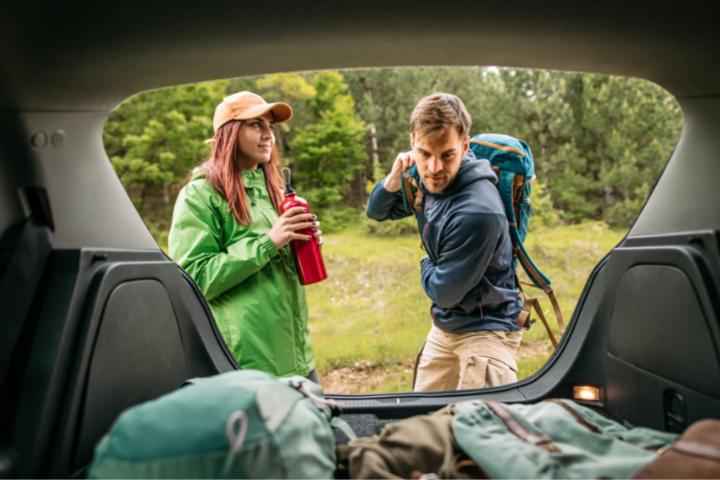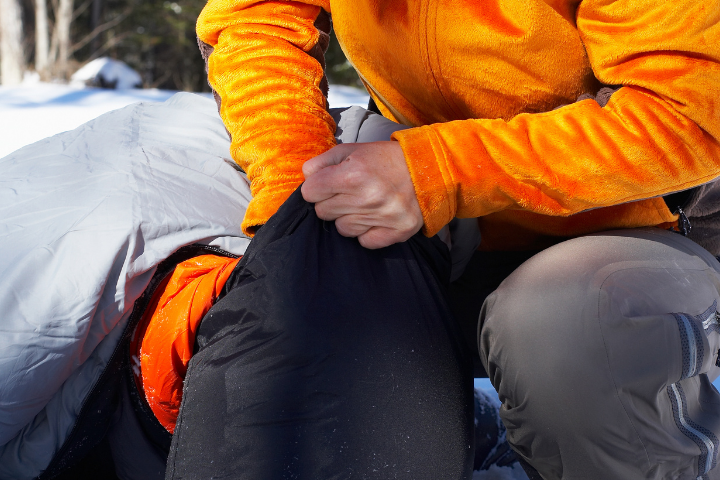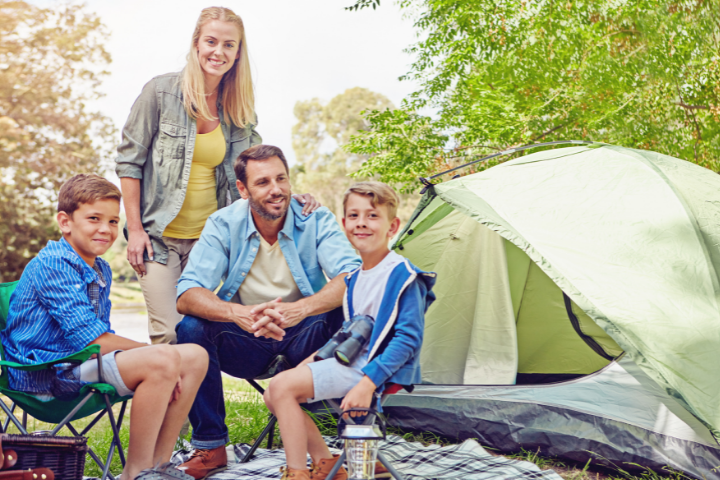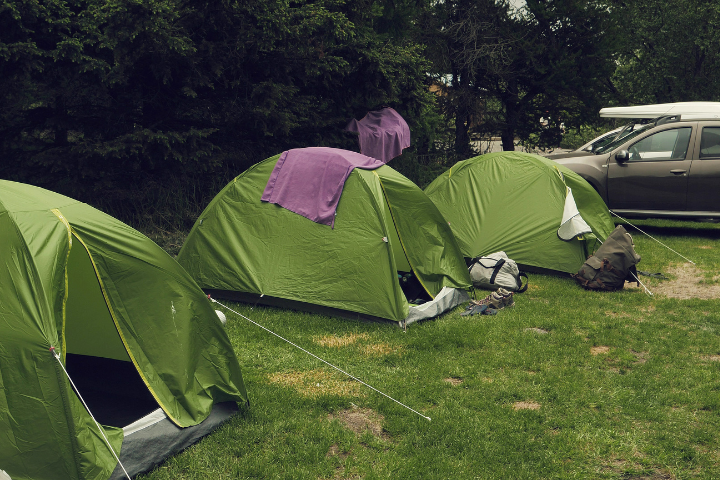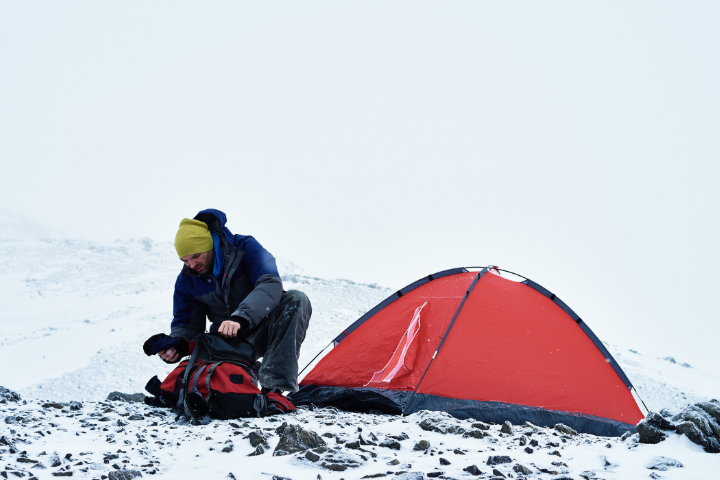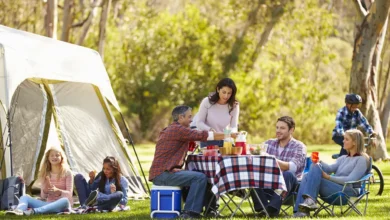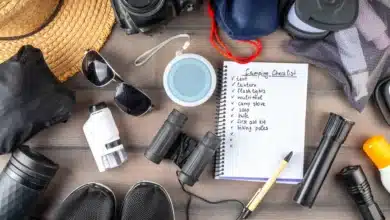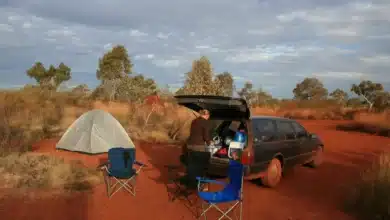This article is a complete guide on what to pack for winter camping and more.
Camping in the winter is so much fun. It very instantaneously gives birth to visuals of barbeque and campfire under the star-studded sky. However, this fun-filled experience in winters may not be as easy and tempting as it looks.
Camping in summer and winter differ in so many ways, one of them being the gear you need for the same. In this article, we will answer all your questions surrounding winter camping.
What Do I Need for Winter Camping?
Let’s get things rolling. The list is quite long, and you can figure out certain aspects as per your needs. All these factors are largely dependent on the intensity of the cold at the camping site.
Tent
You need a roof over your head, after all. Therefore, a tent is easily the most important part of your travel gear. So, make sure you invest in a good quality tent. It protects you from all things extreme, which can be even more extreme in the winter season.
A 4-season tent is an amazing option since it is designed to withstand the toughest of weather conditions. Oh, and since it is winter, you can also build a snow shelter if you have the energy.
It is no secret that snow insulates utterly well, and it is a one-of-a-kind experience to be staying in an igloo. The shelter on the inside is hence so warm that you can enjoy a good sleep.
But, erecting igloos is no cakewalk; they take a lot of work and effort, and hence, it is advisable to carry a tent.
Insulated Sleeping Pad
The insulated sleeping pad functions as a barrier between your body and the chilled ground whence you sleep. One can’t undermine the importance of good sleep on a camp, and hence we can’t stop stressing about how imperative good quality sleeping pads are. Look for sleeping pads with a high R-value.
The higher the R-value, the higher the insulation from the ground. You can choose to hang your sleeping pad outside your backpack or roll it vertically to store it on the inside.
Although bulky in appeal, good-quality sleeping pads are imperative for a comfortable surface for quality sleep after a rough trek.
Sleeping Bag
It would be best if you were careful to check the amount of insulation of sleeping bags before making a purchase. Sleeping bags with less insulation are appropriate for summers. Instead, look for well-insulated sleeping bags that can provide warmth and thermal insulation to the user.
Yes, of course, sleeping bags designed for colder areas are costlier than sleeping bags with less insulation. However, lightweight sleeping bags with relatively less insulation are preferred for kids as heavier ones can make them uncomfortable.
Headlamp
Nights fall early on wintery days. You might be exploring something, and you will suddenly realize it’s dark already; for rushing back to where you have set your camp, it is best to have a headlamp that can guide you back.
So look for sturdy, sufficiently bright headlamps. One must also keep in mind that the cold affects batteries and can damage them, so one needs to have extra batteries in stock, too.
Fuel and Stove
If you are camping at a snow-covered location, you can indulge in making a makeshift kitchen by carving and shaping snow to achieve a shelf, which will make cooking even more fun.
We suggest planning all your meals well in advance and keeping the utensil count minimal. One-pot nutritious meals should be the goal. You can either opt for a liquid-fuel stove or an all-in-one stove system. The latter one is a hit among campers for obvious reasons.
Utensils
One pot and one spoon can do a lot. If you are a minimalist and plan to rely solely on a pot, opt for lightweight materials such as titanium and aluminum. They make cooking in the cold easier. Yes, of course, you would still need disposable or reusable cutlery.
But, if you are opting for a walk-in campsite where you need to unload things from your vehicle and get some serious camping fun going, then you can carry a lot of utensils and yummy food.
Spoons, spatula, bottle opener, grater, lighter, kettle are some of the must-haves per our past experiences.
Water Bottles
Use wider mouth insulated bottles over packaged mineral water since water is likely to freeze. Also, heat the water before adding it to the bottle. Water will not freeze even at extreme temperatures thanks to this method.
Finally, be sure to hydrate yourself throughout the day. Have small sips of water if you are scared you might end up peeing a lot but do sip water regularly.
Thermos Flask
If you are a coffee lover, you cannot miss this one because you won’t be able to enjoy your coffee that much in the chilly winter without a thermos.
Means of Navigation
It is advisable to have a printout of the trajectory you are bound to cover and ensure that you headed to the camp are aware of the routes.
Handsets and google maps are very reliable, but there have to be second options if the latter refuse to cooperate. Also, make sure you download the map offline on your handset. If the network in the area is an issue, you can also opt for the walkie-talkie.
Powerbank
If google maps are what you are relying on, your device would also need a power bank to rely on, which would keep it charged and functional throughout the journey.
First Aid Kit
The first aid kit is your armor. Make sure yours is fully replenished with all possible things that may go wrong with you or your team.
Camera
We know you won’t miss out on this one, but this is just another reminder to carry the camera and all its complementaries, your SD card, batteries, and a good camera bag.
Hand Rub or Sanitizer
Do not forget to carry a sanitizer because you might have to convince yourself it is bad for washing your hands in the cold. Also, attach a small bottle of sanitizer to your backpack or add it to your fanny pack or waist bag.
Toiletries
In a pouch, add all your toiletries which must necessarily include a toothbrush, toothpaste, soap, shampoo, chapstick. You can add and delete as per your requirements and carry travel-size items to avoid your bag from getting heavy.
Backpack
Winter gear is heavy, and so will be your backpack. Therefore, it would help if you had a heavy-duty, big backpack for a winter camp. Investing in a good-quality backpack is one of the foremost requirements for winter camping.
One can also consider a sled as an alternative. However, if you wish to opt for the same, you must carry a separate backpack for easy access to water, eatables, and avalanche safety gear.
Bin Bags
Carry with yourself bin bags or a small pouch, where you throw in all the waste you generate because if you are camping at a remote location, there are chances that you won’t spot bins that frequently.
Dispose of food waste and other things responsibly. It would help if you also had appropriate disposal options when on a period because carrying things on one backpack is a big task in itself.
Pack Thoughtfully.
Be a minimalist in makeup and aesthetics but a maximalist in clothes, utensils, disposal options, camping gear.
What Do You Wear for Winter Camping?
Warm jacket
When the temperatures begin to dip, having a thick layer of insulation on you becomes imperative. However, this does not mean that the jacket should be so heavy that it creates muscular pain and the likes in your body—Hunt for a quality warm jacket that is light but does its job well.
It might start snowing, and your jacket must be waterproof. Duh! Winters can be harsh, after all. Run away from poor-quality lightweight jackets or use them as a mid-layer. A hardshell jacket would also be an excellent purchase for winter camping.
Warm pants
While some would want to opt for trek pants, the winter might get harsh, and they might not be enough. So you can either wear another layer beneath them or opt for winter pants that are thick, warm, and can deal with the harsh winter.
Eye protection
Eye protection is imperative, do not consider it as an option. Snow blindness is real, and it is the last thing you would want to deal with in such cold temperatures. Glacier goggles or performance-oriented sunglasses are known to offer the best protection.
Warm Socks
Cotton socks, in general, have low insulation value. Also, cotton socks lose the little insulation they offer once they get wetness. This wetness can be because of water or sweat and moisture.
Wool, particularly merino wool socks, would be an ideal recommendation for camping in the winter. While purchasing socks, be smart to keep in mind the insulating value of your snowshoes; too much warmth while walking makes the wearer uneasy.
However, a pair of warm, cozy socks that run till the knees or slightly below would be the perfect choice for when you are not walking but sitting in the camp and raising a toast or sleeping.
Warm Gloves
Look for very warm gloves because you cannot afford to let your hands run cold. Carry at least one spare pair of gloves.
Cap
Catching a cold at a winter camp is the last thing to do. Carry along with a warm cap that prevents the cold from hitting your head and giving you a headache or a runny nose. Winter nights call for a warm and heavy beanie to cover your head.
Snowshoes
Snowshoes work by distributing the wearer’s weight over a larger surface area so that the wearer does not sink into the snow. The same is called flotation. One may end up plunging into snow knee or even waist-deep if they are not wearing snowshoes.
Layering for Winter Camping
One cannot undermine the need and importance of layering for winter camping. Three layers are recommended for top wear, and one or two can be sufficient for bottom wear.
Baselayer
The base layer should be comfortable; it is in direct contact with your skin and will carry the weight of two other layers. Therefore, look for lightweight, breathable material for your base layer.
One must carry at least two base layers or even more, excluding the one you are wearing for three to four-day camping. If you sweat a lot in general and prefer to wear squeaky clean clothes after every few hours, you must do the math and carry lots of base layer clothing so that you do not run out of clean and dry clothes.
Midlayer
The mid-layer should be warm, breathable, and easy for customization. Look for zippers or cardigans so that you can easily get rid of the mid-layer mid-journey if you wish to do so, adding too much warmth.
How Cold Is Too Cold To Camp?
Nighttime temperatures between 50 to 65 degrees Fahrenheit are ideal for camping. However, when temperatures dip and look like 30 to 40 degrees Fahrenheit, it is too cold to camp.
Temperatures below 30 degrees are difficult to handle, especially for inexperienced campers or those with cheap travel gear. However, the campsite you chose plays a large role in determining the temperatures you will witness.
How to Choose the Campsite?
Choosing your campsite by assessing multiple factors is essential, especially if you have a lot of people involved.
Optimum wind flow patterns
Do not choose a campsite that has too much wind movement or a campsite with no wind movement at all. Instead, look for an option just in the middle of the former and latter for optimum temperatures.
Are all the people physically and mentally fit to deal with the cold?
One must make a checklist to consider whether all the people in the group are experienced or physically fit to deal with cold extremes is perhaps the most imperative bit of winter camping. If you are starting, this becomes even more critical.
Consult a professional.
One must consult with professionals before hopping on to the winter camp bandwagon, or else opt for a beginner’s site and wait until you have the hang of it to go for tougher and harsher locations.
How Do You Keep a Tent Warm in the Winter?
Cold nights and freezing tents are a mini horror story in themselves. Here is a list of things you can do to keep your tent warm.
Use a tent heater
Using a tent heater is the most obvious and simplest reply to the question as mentioned above. However, one must be very careful with heaters. They must not be left running all night.
A Bottle of Hot water
How to heat a tent without electricity? Well, the answer is simple: hot water bags. One bottle of hot water can do so much, and it can warm the insides of your blanket and even help relieve pain and cramps in your body.
Carrying hot water bottles is hence strongly recommended. Moreover, chargeable variants of these water bottles are available in the market where all you need to do is plug the bottle into the charging source and use it for a good one to two hours and recharge again.
Carry Mylar Blankets
Mylar Blankets reflect heat the surroundings back into their origination position. Inside tents, one can use duct tape to attach them to the top of the tent and then let the mylar blanket do its magical wonders.
As if this was not it, mylar blankets are easily available at camping stores and are quite inexpensive. One Mylar Blanket for one tent is good enough. Oh yes, just in case you wonder, mylar blankets and space blankets are the same things.
Keep the tent ventilated.
It may sound like we are misinformed or giving incorrect advice, but we are fully aware of what we are saying. While blocking the air passages into the tent to maintain warmth, keeping the tent ventilated is imperative. Keeping the tent ventilated reduces dampness and condensation inside the tent.
Dress warmly.
Wear the thermals to sleep too.
While some find it uncomfortable and inconvenient, wearing a thermal to sleep once in a blue moon that is freezing outside would do more good than warm. However, one must ensure that the thermal is of good quality and imparts good breathability.
Wear completely dry clothes.
Do not be lazy and sleep in sweaty clothes. No matter how hard it seems, change into a set of fresh and clean clothes for the night. Ensure your socks and gloves are completely dry.
Damp clothing can lead to chillier experiences and even lead to the wearer catching cough and cold. Carry enough pairs of socks and gloves to prevent your feet and hands from running cold.
Keep your head warm.
Wear your warm beanie or wrap a warm muffler around your head to keep your head warm through the night.
Make use of heated rocks from the campfire.
You can safely wrap slightly cooled stones from the campfire into a towel and place the same close to your sleeping pad. Campers and hikers have used this method for ages, and it imparts warmth for quite some time.
Add layers to the bottom of the tent.
Adding layers helps in insulation at the ground level. Have you seen visuals of professional campers or otherwise making a bed of leaves and pine branches underneath their sleeping surface?
There is a logical reason behind that. This layer of insulation can help bulk up the heat retention in your tent. One can alternatively opt for placing a foam exercise mat underneath their sleeping mattress or pad.
Sleeping Bag Liners
Add some more layers. Use sleeping bag liners. Cotton, breathable and lightweight sleeping bag liners can serve as the reason for a good night’s sleep in the winter.
They add the necessary insulation layer between your body and the surroundings and ensure you do not run cold. What’s more? Sleeping bag liners are easier to wash than sleeping bags themselves.
Make sure you choose your tent wisely.
The size of your tent is also going to determine how easily and quickly one can heat their tent. A big tent, as is obvious, requires more space and time to heat.
But, on the other hand, a small tent will conversely get heated easily and quickly. Hence, it is advisable to choose a tent which matches your requirements.
Do not sleep alone in a tent.
If you have already made a purchase and the tent is big, opt for sharing your tent. The more people, the less cold there will be. In addition, more people means more body heat which is one of the best ways to keep the tent warmer.
Avoid air mattresses.
It is not good to use air mattresses in the winter season because the air inside the mattress cools down faster, leaving the person feeling cold at night. Because of this, many people report being shivering all night and therefore being unable to sleep.
If you choose to opt for the air mattress regardless, be sure to add a few layers on top of the air mattress, such as a foam pad or quilt, to ensure insulation between the human body and the cold air.
Decide Which Camping Site Is Right for You, and the Rest Will Follow.
Our first advice is also our last advice: choose your site wisely. Our second and concluding advice is to ensure you have everything needed to make the right setup to keep you and your mates warm. We leave you with this guide to setting up your winter campsite
Also, here are a few last questions before you leave. Do you now feel more confident about your upcoming camping session? Let us know your experiences, doubts, stories in the comment section down below. Spread the word, give the article a share. Thanks for stopping by. We will see you soon with another article.
